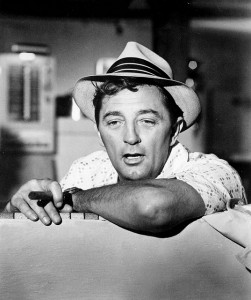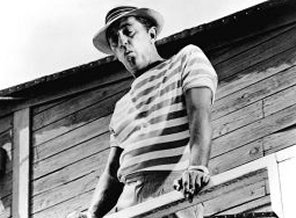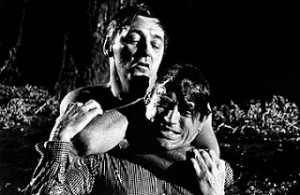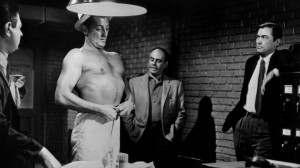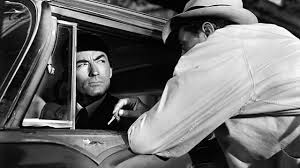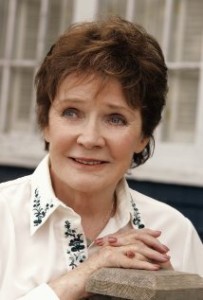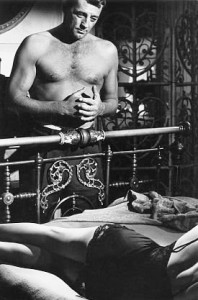Cape Fear ***** (1962, Robert Mitchum, Gregory Peck, Polly Bergen, Martin Balsam, Telly Savalas, Jack Kruschen) – Classic Movie Review 176
The 1962 crime thriller film Cape Fear stars Robert Mitchum, who hypnotically plays sadistic Max Cady, an ex-con sex-offender out to get the man he blames for his conviction, upright lawyer Sam Bowden (Gregory Peck).
Director J Lee Thompson’s 1962 black and white neo-noir psychological crime thriller film Cape Fear stars Robert Mitchum, who hypnotically plays the revoltingly sadistic Max Cady, an ex-con sex-offender out to get the man he blames for his conviction, upright small-town lawyer Sam Bowden (Gregory Peck).
Out after serving eight years in jail for rape after Bowden interrupted his attack on a young woman and testified against him, the vengeful Cady comes on like the monster who never dies, prepared to stalk the attorney and his family to the bitter end. The good don’t have enough weapons to fight the evil.
Incidentally in the novel Cady was a soldier court-martialed and convicted on Lieutenant Bowden’s testimony for the brutal rape of a 14-year-old girl. But the US film censors banned the use of the word ‘rape’ and said making Cady a soldier reflected adversely on the US military.
This masterly, nerve-jangling 1962 thriller, based by screenwriter James R Webb on John D MacDonald’s 1957 novel The Executioners, is a real gripper from British action director J Lee Thompson (The Guns of Navarone, also with Peck). Thompson is to be greatly commended for this distinguished piece of work.
Recalling his demonic role in The Night of the Hunter, Mitchum is chillingly riveting as he embarks on a campaign of terror, threatening Peck’s wife Peggy (Polly Bergen) and 14-year-old teenage daughter Nancy (Lori Martin). He learned law in prison, so this can help him target the Bowdens, but he has always had a knowledge of violence and the first victim this time is their dog. Bowden’s friend, Police Chief Mark Dutton (Martin Balsam) tries to help Bowden but cannot prove Cady guilty of a crime, so tells Bowden to hire private detective Charlie Sievers (Telly Savalas).
This clever set-up leads one long continuous sequence of corkscrew tension, finally ending up in a scalding climax the steamy Florida swamps that few thrillers can rival.
Peck and Mitchum are perfect, the yin and yang of good and evil. Mitchum’s role is showier, so it is a bit easier to shine. So you can see Peck’s brilliance in his portrayal of an honest, good man under threat and in crisis, a man who has dragged his beloved family into the swamp with his attempt to act honestly and fairly. The courtroom is no place for the truth, apparently, and nor is the world, certainly not the film noir world. Anyway, honest has desperate consequences.
Great though the star duo are, there is also impeccable playing by the whole cast. Martin Balsam (Bowden’s police chief buddy), Jack Kruschen (the other attorney, Dave Grafton) and Telly Savalas (the private detective the family hires to help) are essential cast members. Boy, there were great characters actors back in those days! Also Edward Platt and November 1958 Playboy Playmate centerfold Joan Staley appear briefly as a judge and a waitress. And Barrie Chase plays Diane Taylor, a young woman Cady brutally rapes when he brings her home.
In a model of direction, an inspired Thompson keeps the thriller throbbing nervously along, never once letting up on the tension or the terror. Bernard Herrmann’s grandly ornate score makes a major contribution to the film’s bull’s-eye effect. Sam Leavitt’s film noir-style black and white cinematography is stunningly atmospheric, adding enormously to the all-pervading atmosphere of doom and gloom.
Thompson complained that UK censor John Trevelyan had ruined the film by making extensive cuts for the cinema release. Trevelyan replied he had made only 15 cuts, totalling around six minutes, with edits made to threatening dialogue and assault references, Cady’s attack on Peggy, and all shots of him staring longingly at Nancy. But all later UK video releases restore the cinema cuts.
Thompson said he had to make 161 cuts. The censor said it was 15 main cuts but admitted they took five minutes, primarily because the film involved threat of sexual assault against a child.
Peck, who produced the film, did not like the novel’s title The Executioners and decided that movies named after places tended to be successful. So he looked at a US map and happened on Cape Fear in North Carolina. But, alas, the film wasn’t successful and its financial failure ended Peck’s company, Melville Productions.
Peck said he was not impressed when Mitchum told everyone he had acted Peck off the screen: ‘I had given him the role and had paid him a terrific amount of money. It was obvious he had the better role. I thought he would understand that, but he apparently thought he acted me off the screen. I didn’t think highly of him for that.’
Mitchum said that during the filming of their final fight scene Peck accidentally punched him for real. Mitchum continued filming but later ‘literally collapsed’. Bergen recalled that Mitchum cut open his hand while filming the scene in which he attacks her character on the houseboat: ‘His hand was covered in blood, my back was covered in blood. We just kept going, caught up in the scene. They came over and physically stopped us.’ The houseboat scene was largely improvised. Thompson suddenly told a crew member: ‘Bring me a dish of eggs!’ so Mitchum’s rubbing the eggs on Bergen was not scripted and Bergen’s reactions were real.
The outdoor scenes were filmed in Savannah, Georgia; Stockton, California; and the Universal Studios backlot at Universal City, California, while interiors were shot at Universal Studios soundstage. Mitchum hated Savannah, where as a teenager he was convicted of vagrancy and put on a chain gang, so some outdoor scenes, including the houseboat conflict climax, were shot at Ladd’s Marina in Stockton instead.
Peck was impressed by Thompson’s work on the 1961 The Guns of Navarone and hired him for Cape Fear. Peck said he wanted to make ‘first class professional entertainment intelligently done’. Thompson planned the film in stylish black and white with striking Alfred Hitchcock-style elements, such as unusual lighting angles, eerie musical score, closeups, mounting suspense, and subtle hints of the violence to come.
It was remade by Martin Scorsese as Cape Fear in 1991, with Robert De Niro Nick Nolte and Jessica Lange, and Peck, Mitchum and Balsam in support roles. Scorsese reuses Herrmann’s soundtrack in his remake.
Cape Fear is a coastal plain and Tidewater region of North Carolina centered about the city of Wilmington, named after the adjacent Cape Fear headland and the Cape Fear River that runs through the region and empties into the Atlantic near the cape.
Polly Bergen died on aged 84.
http://derekwinnert.com/cape-fear-1991-classic-film-review-177/
© Derek Winnert 2013 Classic Movie Review 176 derekwinnert.com
Link to Derek Winnert’s home page for more film reviews: http://derekwinnert.com/

